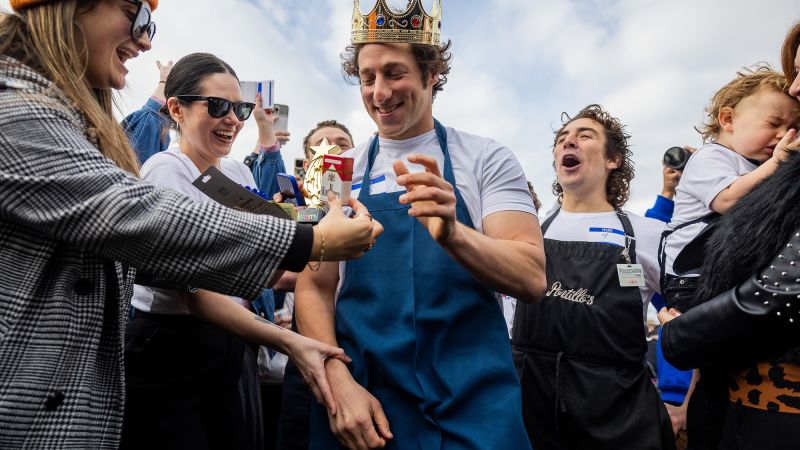In the realm of German folklore, doppelgängers are perceived as ominous figures, heralding misfortune wherever they appear. In contemporary society, however, the trend towards celebrating celebrity lookalikes has surged, often in stark contrast to the troubling backdrop of geopolitical strife, climate disasters, and economic turmoil. This phenomenon seems to reflect a collective fascination with identity and similarity, finding expression in an array of eccentric lookalike contests that invite communities to come together while simultaneously invoking the eerie specter of the doppelgänger.
The recent doppelgänger craze kicked off with actor Timothée Chalamet stepping into the limelight, captivating a throng of hundreds at Washington Square Park who gathered to witness the unofficial contest in which over a dozen Chalamet impersonators vied for the title. Organized by YouTuber Anthony Po, this memorable event spiraled into chaos, culminating in several arrests and a $500 fine, while also drawing a surprise appearance from Chalamet himself. Contestant Reed Putman recounted the event, describing the whirlwind of fans eager to capture the moment, noting the surreal experience of being surrounded by cameras and curious spectators.
Following the frenzy surrounding Chalamet, other cities quickly hosted lookalike contests. In Ireland, aspiring doppelgängers of Paul Mescal donned their best Gaelic Athletic Association shorts to draw attention and compete for a jackpot of €20 ($21). Interestingly, the allure of Mescal even led to a second contest organized in a London pub, establishing him as a unique figure within this quirky competitive landscape. In London’s Soho Square, another cohort of young men clad in elegant pussy-bow blouses were out to prove themselves as the ultimate impersonators of singer Harry Styles. Across the United States, similar contests blossomed featuring actors like Dev Patel in San Francisco and Zayn Malik in New York, while Chicago saw a gathering of enthusiasts channeling Jeremy Allen White, laden with props inspired by his role in the show “The Bear.” The excitement spread so far that Zendaya became part of the trend, having her own contest take place in Oakland, California, establishing another notable marker in the growing arena of celebrity doppelgänger shows.
Social media has played a pivotal role in proliferating this trend, with viral competition posters appearing seemingly every week. Many of these contests promise not only small cash prizes but also celebrity-themed rewards—many of which humorously reflect the character of the celebrity being impersonated. The wave of excitement generated by these contests resonates with a certain demographic, particularly Gen Z and Millennials, akin to a cultural dog whistle. Despite their modern resurgence, lookalike contests are not a recent invention; they are deeply rooted in entertainment history.
Lookalike competitions echo back to the years of Hollywood’s Golden Age, where Charlie Chaplin Jr. reveals in his memoir that his father entered such a contest and managed to secure a third-place finish. Similar competitions dedicated to film star Shirley Temple emerged in the 1930s in locations such as Sydney and Cleveland, garnering significant participation. Over the decades, cases of celebrity impersonation have steadily evolved, with a Key West bar celebrating Ernest Hemingway through an annual lookalike event for four decades.
Ellis Cashmore, a noted British sociologist and cultural critic, suggests that this contemporary resurgence of lookalike contests resonates with a significant observation: many individuals associate their identities with fluidity and the potential for transformation. This notion comes at a time when society embraces the idea that anyone can reinvent themselves, a stark departure from the idea of fixed destinies tied to biology or genetics.
The story of doppelgängers intertwines with the human experience, exploring deeper themes of community and connection. These events, according to Cashmore, create a unique environment for individuals to interact, fostering new relationships and connections based on a shared passion for celebrity culture that might not otherwise prevail in typical social settings.
Additionally, Andy Harmer, a professional David Beckham lookalike and founder of a celebrity impersonator agency in the UK, adds a scientific angle to the discussion. He cites the innate human fascination with symmetry and resemblance, often evident in nature through mimicry, such as stick insects and bee orchids.
Despite the humorous and light-hearted aspects of these competitions, Harmer acknowledges the complexities faced by impersonators. He recounts tumultuous experiences during high-stakes moments when Beckham faced public backlash, revealing how the birthplace of fame can draw both admiration and disdain.
Driven by science, Dr. Manel Esteller, a geneticist at the University of Barcelona, points out that each person has at least seven doppelgängers globally, reinforcing the idea that the quest for resemblance and identity is both biological and cultural. Lookalikes, he notes, demonstrate varied degrees of resemblance that challenge fixed perceptions of identity.
Ultimately, for those who possess a striking resemblance to celebrities, opportunities abound. Harmer illustrates how successful lookalikes can find good fortune in this niche, even



